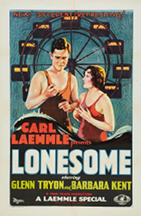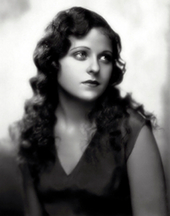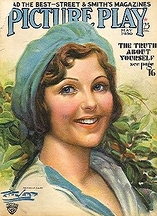 One of the primary benefits—for a movie buff, anyway—of living in a city like New York is getting the chance to see cinematic rarities that one just doesn’t have the opportunity to view in, say, Oklahoma City or Toledo or Salt Lake City.
One of the primary benefits—for a movie buff, anyway—of living in a city like New York is getting the chance to see cinematic rarities that one just doesn’t have the opportunity to view in, say, Oklahoma City or Toledo or Salt Lake City.
Some years ago, we were delighted by our first viewing of Pál Fejös‘ mostly silent (two or three scenes with dialogue were added as an afterthought) 1928 effort, Lonesome. It was rarely screened, we were led to understand, because few copies were known to exist; the print we saw was from the collection of the George Eastman House in Rochester, New York.
Eastman House wasn’t stingy with the print, exactly, but neither did they blithely send that one extant copy bouncing around the country for multiple screenings. We caught the picture every time it was screened in NYC, so we managed to see it perhaps four or five times over the years, but we wondered all the while why it wasn’t restored and released on DVD.
We need wonder no more, as the Criterion Collection, bless their hearts, have stepped up to the plate and arranged a DVD/Blu-Ray release that debuted in late August.
Lonesome could not be more charming. Its appeal is based in large part on the fact that much of it was filmed on Coney Island, and any glimpse of that magical setting as it was in the 1920s is to be treasured.
But the plot of the picture is engaging, too. It tells the tale of two lonely Manhattanites, played by Glenn Tryon and Barbara Kent, who experience a chance meeting at Coney and go on to spend a magical day together before getting separated that evening, with neither having learned the other’s last name. In a city of millions, will they ever manage to find each other? (If you think we’re going to tell you how it turns out, you can think again. No blabbermouths, we.)
Lonesome was originally released as a silent picture, but with all the fuss over the new sound technology, it was decided to bring back all involved parties to film three scenes with synchronized music and dialogue. So it’s not quite a silent and not quite a talkie.
But it’s certainly delightful, and we encourage you to, at the very least, rent the Criterion release (really, you should be buy it, as such adventurous releases should be encouraged—and besides, there are two other Fejös’ pictures included in the package, The Last Performance (1927) and Broadway (1929). That’s three rarities for the price of one, a deal that’s hard to beat.
Fejös wasn’t in the movie business terribly long, but he left his mark with audaciously daring camerawork, a sample of which we’re sharing below. These few minutes of video are from the opening scenes of Lonesome and show our young protagonists striving to make it to work on time.


